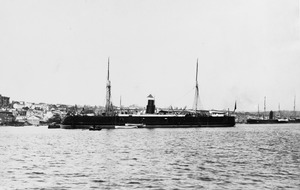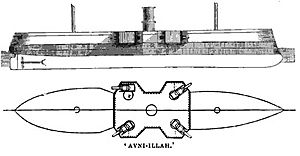Ottoman ironclad Muin-i Zafer facts for kids

Muin-i Zafer in Constantinople, sometime before 1894
|
|
Quick facts for kids History |
|
|---|---|
| Name | Muin-i Zafer |
| Namesake | "Aid to Triumph" |
| Ordered | 1867 |
| Builder | Samuda Brothers, Cubitt Town |
| Laid down | 1868 |
| Launched | June 1869 |
| Commissioned | 1870 |
| Decommissioned | 1932 |
| Fate | Broken up, 1934 |
| General characteristics | |
| Class and type | Avnillah-class ironclad |
| Displacement | 2,362 metric tons (2,325 long tons) |
| Length | 68.9 m (226 ft 1 in) (lpp) |
| Beam | 10.9 m (35 ft 9 in) |
| Draft | 5 m (16 ft 5 in) |
| Installed power |
|
| Propulsion |
|
| Speed | 12 knots (22 km/h; 14 mph) |
| Complement |
|
| Armament | 4 × 228 mm (9 in) guns |
| Armor |
|
The Muin-i Zafer (pronounced Moo-in-ee Zah-fer), which means "Aid to Triumph" in Ottoman Turkish, was a powerful warship built for the Ottoman Navy. It was the second of two ships in its class, called the Avnillah-class class. These ships were special because they were casemate ships, meaning their main guns were protected inside an armored box in the middle of the ship.
Muin-i Zafer was ordered in 1867 and finished in 1870. It had four large 228 mm (9 in) guns and could travel at a top speed of 12 knots (22 km/h; 14 mph). The ship was involved in the Russo-Turkish War in 1877–1878, helping Ottoman soldiers. After the war, it was kept in reserve and slowly became old and worn out.
By 1897, when the Greco-Turkish War started, the ship was not ready for battle. It was later rebuilt and used for different jobs, like a training ship and a barracks ship. Finally, in 1928, it became a depot ship for submarines. Muin-i Zafer was taken out of service in 1932 and taken apart for scrap metal in 1934.
Contents
Ship Design and Features
The Muin-i Zafer was 68.9 m (226 ft 1 in) long and 10.9 m (35 ft 9 in) wide. It sat 5 m (16 ft 5 in) deep in the water. The ship's body was made of iron and had a special "double bottom" for extra strength. It weighed about 2,362 metric tons (2,325 long tons) and had a crew of 15 officers and 130 sailors.
Engine and Speed
The ship was powered by one main engine that turned a single screw propeller. Four coal-fired boilers created steam for the engine. These boilers sent smoke up a single funnel in the middle of the ship. The engine could produce 2,200 indicated horsepower (1,600 kW) of power, allowing the ship to reach 12 knots (22 km/h; 14 mph). However, over time, its speed dropped. By 1877, it could only go 10 knots (19 km/h; 12 mph), and by 1892, it was down to 8 knots (15 km/h; 9.2 mph) due to poor upkeep. The ship could carry 220 t (220 long tons; 240 short tons) of coal. It also had sails, like a brigantine rig, to help it move.
Armor and Weapons
The Muin-i Zafer had four large 228 mm (9 in) guns. These were muzzle loading guns, meaning they were loaded from the front. They were placed inside a strong, armored casemate in the center of the ship, with two guns on each side. The guns were positioned so they could fire straight ahead, straight back, or to either side of the ship.
The ship's armored belt was 127 to 152 mm (5 to 6 in) thick. The thickest part was above the water, and it extended a bit below the water line. The casemate, where the guns were, had even thicker armor, with 152 mm of iron plating to protect the weapons and crew.
Ship's History
The Muin-i Zafer, meaning "Aid to Triumph," was built by the Samuda Brothers shipyard in London. Its construction began in 1868, and it was launched in June 1869. After testing, it officially joined the Ottoman fleet in 1870.
When it was new, Muin-i Zafer and other Ottoman ironclads were sent to Crete. This was to help bring peace to the island after a revolt. During this time, the Ottoman fleet didn't do much fighting. They mostly practiced by reading translated British instruction books. Muin-i Zafer was part of the II Squadron of the Asiatic Fleet. In its early years, the Ottoman ironclad fleet would take short trips every summer to make sure their engines were working.
Russo-Turkish War (1877–1878)
In September 1876, the Ottoman fleet started getting ready for a war with Russia. Tensions had been rising for years. In December 1876, Muin-i Zafer and its sister ship Avnillah moved to Batumi, where Russian naval forces were active. The Russo-Turkish War officially began on April 24, 1877.
Muin-i Zafer spent the war in the Black Sea squadron. The Ottoman fleet in the Black Sea was much stronger than the Russian fleet there. Even though they had a stronger navy, the Ottoman leaders didn't use it to stop the Russian army from advancing. Instead, the fleet went to the eastern Black Sea to support Ottoman soldiers fighting in the Caucasus region.
The fleet attacked the city of Poti and helped defend Batumi. On May 14, 1877, a group of Ottoman ships, including Muin-i Zafer, attacked Russian positions near Sokhumi. They also landed soldiers and gave weapons to local people to start a rebellion against the Russians. The Ottomans captured Sokhumi two days later. By June, Muin-i Zafer was moved to Sulina at the mouth of the Danube river. Its job there was to protect the port from the sea and support three forts.
Later Years and Modernization
After the war ended in 1878, the ship was kept in Constantinople and didn't see much action for the next twenty years. The yearly summer trips stopped. The ship did get some small updates. In 1882, two new breech-loading guns were added. It also got new boilers, and its sails were removed. The Ottomans had plans for more weapons, but these plans never happened.
By the mid-1880s, many Ottoman ironclads were in bad shape, including Muin-i Zafer. Their engines were rusted, and their hulls were dirty from being in the water too long. It would have taken months to get just a few ships ready for sea. The ship's crew was also much smaller than it should have been. During a tense time with Greece in 1886, the ships were prepared, but none actually left the harbor. Most ships could only go about 4 to 6 knots (7.4 to 11.1 km/h; 4.6 to 6.9 mph) by then.
When the Greco-Turkish War began in 1897, the Ottoman fleet was inspected. Almost all the ships, including Muin-i Zafer, were found to be unfit for battle. Their hulls were rotting, and their crews were not well trained. This was embarrassing for the government. So, Sultan Abdul Hamid II finally allowed a plan to modernize the ships.
An Italian company, Gio. Ansaldo & C., took over the project to rebuild Muin-i Zafer. The work was finished by 1906. Its old guns were replaced with new, more modern 150 mm (5.9 in) guns. It also received smaller, quick-firing guns for defense.
In 1910, Muin-i Zafer became a stationary ship in İzmir, and most of its weapons were removed. In September 1911, the Italo-Turkish War began. Muin-i Zafer was a guard ship in Beirut at the time. It soon left and went to Port Said at the end of the Suez Canal. There, its remaining guns were taken off and used to defend the land.
By October 1912, at the start of the First Balkan War, Muin-i Zafer was back in İzmir. In 1913, it became a torpedo training ship in Constantinople. Later, in 1920, it was turned into a floating barracks in İzmit. Its final job was in 1928, when it became a depot ship for submarines in Erdek. After four years in this role, it was taken out of service in 1932 and broken up for scrap metal in 1934.
Images for kids



